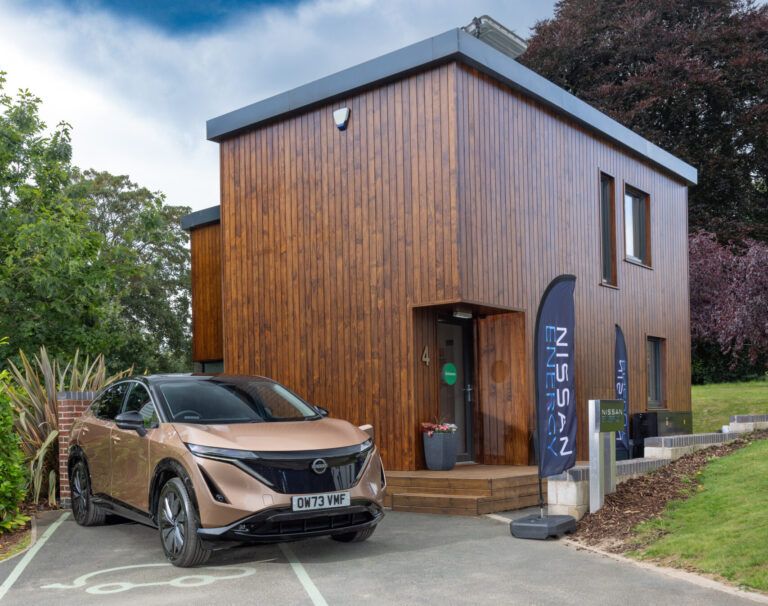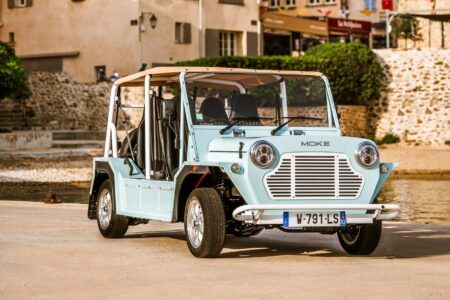Vehicle-to-grid development, battery innovations and a smooth transition from ICE to EV, Nissan engineers around the world have a lot on their collective plates. John Challen finds out what they are up to
With an ever-growing number of EVs – from legacy manufacturers as well as startup organizations – continuing to flood the automotive market, drivers are not short of options. And the technologies and innovations keep on coming. Some might say that the level of maturity the industry has seen might mean it’s time to take the foot off the gas (or rather the electricity), but R&D teams know otherwise.
For Nissan, the current big targets that require a huge amount of investment, engineering and enthusiasm are vehicle-to-grid (V2G) capabilities and bringing solid state batteries to market. The Japanese manufacturer recently revealed more plans in these areas and suffice to say, it is fully committed to seeing them through.
In the case of V2G, Nissan confirmed that onboard bi-directional charging would feature on selected EVs from 2026. The news came as a boost for the OEM’s business plan – The Arc – which stated the requirement to deliver ‘differentiated innovation that enables the EV transition, while unlocking new revenue streams’. The V2G project also sits at the heart of Ambition 2030, Nissan’s long-term vision of a world that is cleaner, safer and more inclusive.
“Everywhere in the world, the energy market is clear where we can give more to our customers. It’s very promising for them because, if we play it well, we will stop speaking about zero emission and it will be negative emission,” says Hugues Desmarchelier, vice president of global electrification ecosystem and programme director for EV cars at Nissan. “If things go to plan, every car that we sell will potentially be able to help the grid and the energy market by using renewable energy more of the time. That’s not just when you’re driving an EV, it’s also when you’ve parked the vehicle, because you can help the grid by giving power back.”
In this win-win situation, Desmarchelier believes that this approach will cancel out the carbon footprint generated by car manufacturing. “If you can reduce the CO2 footprint when you build the car, then we can have what I wish for my kids – a world where, when you buy an EV, you are not only carbon neutral – potentially – you can also have a positive impact on the CO2 all over the world.
“We started vehicle-to-home projects a long time ago and we have 18,000 customers involved with it in Japan. But today you need subsidies in order to make it work, because it is an expensive process,” he admits, explaining that more than 40 pilot projects since 2012 have convinced Nissan that V2G is the right way forward. “Today, we are at the beginning of this journey – and that’s why we don’t want to wait. Even though the regulation is not always ready, with our partners we are trying to force our way into this world to make a difference from today. But really, we are preparing for the future.”
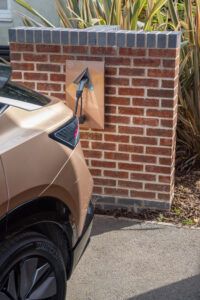 Model performance
Model performance
Nissan EVs that are equipped with V2G bi-directional charging technology will contribute towards helping the electricity grid, especially at peak times. Starting with the UK but looking to rollout the technology all over the world, Nissan has already achieved G99 Grid code certification with an AC-based solution for a V2G application. Awarding of the benchmark follows a year-long project at the University of Nottingham, where studies showed the potential for V2G, for drivers and also the wider industry – and the world.
David Moss, SVP of research and development for the AMIEO region at Nissan believes V2G is also needed make EVs more affordable and profitable. “Our aim is to bring the cost of our vehicles down by 35%,” he explains. “Alongside the cost reduction, we are also looking to improve efficiency and also the driving experience.” Nissan’s approach is concentrated on common powertrain components wherever possible, which has led to its ‘X-in-1’ powertrain setup. That means in either a 3-in-1 (EVs) or 5-in-1 (ePower) configuration, the inverter, reducer and motor will be commonized and modularized. For ePower, an increaser and electric generator will be added into the mix but designed and developed to maximize efficiency. The result will be powertrains that are up to 25% smaller than the current versions.
Plant growth
Bolstering Nissan’s offering in the EV industry is a huge investment in battery technology and production, as well as ongoing R&D into different types of chemistries that could be suitable for future vehicles.
For example, a Gigaplant that is currently under construction in Sunderland, UK is a joint development between Nissan and battery manufacturer Envision AESC, and covers an area the equivalent of 23 soccer pitches. That seems huge but, as Moss points out, it’s only really capable of supporting one of the EVs that being produced at the Japanese manufacturer’s factory nearby. What’s important, however, is the product being built there. “We’re using a new chemistry because we are committed to moving the product on – both from a cost point of view, but also an energy density standpoint,” he explains. “We’re focusing on nickel manganese cobalt (NMC) and all-solid-state batteries (ASSB). In Japan there is some work going on around lithium iron phosphate (LFP) cells, but they are not as energy dense, and they are heavy too. Obviously one of the biggest challenges with EVs is, efficiency, because efficiency is king.
“Aero is very much dictated by the styling, so we always need to make the car light,” he adds. “So, looking at the components – and how we improve the efficiency of them – is the big driver. For us, it’s all about working out how we can get more out of the battery and onto the driving range – because our customers measure things on how far they can go. That and charging speeds.”
Early results gathered by Nissan engineers show a lot of promise for ASSB. “For the prototype parts that we’ve been testing, we do see a jump in the performance [over existing technologies]. Some people might have other technologies up their sleeves but, so far, we see a big job, and we’re committed to working on it,” says Nissan’s Shunsuke Shigemoto, VP e-powertrain and advanced research.
“The key thing is making sure there’s no liquid in it,” furthers Moss. There’s solid state and then there’s all-solid-state – and we are concerned with all solid state. Liquids are temperature-dependent and want to change state. When the electrolytes boil, they create gasses, and they want to react with everything that’s around them. In terms of driving and charging, you get to the point where the battery management kicks in to control the temperature of the battery. With solid state, you’ve got less of an issue, so you just keep charging.
“We’ve done loads of simulations where we always look at an 800km drive and, when you travel those distances, we have to factor in how long you are going to drive before you need to stop at the services or for lunch,” adds Moss.
Infrastructure is interesting, says Moss and another area that Nissan has investigated. “We do a lot of surveys across Europe and, now we tend to find that, for any chargers going in now, voltage isn’t a problem. We do see an issue with the current and how that current is divided between one or more vehicles being charged. We’ve looked at what the available charging power is and what kind of voltage to put on board for your charger. Getting that balance right is a big challenge because obviously the different voltages on the onboard changes the power electronics a lot.”
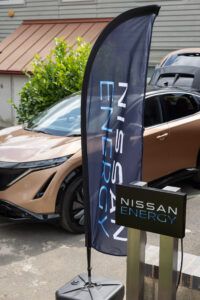 Solid as a clock
Solid as a clock
Looking ahead in time, Nissan has committed to introducing its first solid-state batteries in an application by 2028. A date for price and performance parity with existing technologies, however, is a little less clear. “A lot of it is down to investments and payback and, when you put it into another car, it’s never the same just swapping a Duracell for an Ever Ready,” reasons Moss. “The batteries behave so differently. So, if we change the cooling and all the other algorithms around it, we have to consider how long the car has been in the market and if the payback has been made on the original battery investment.
“Another issue is around the size and packaging implications,” he adds. “What does that do with the packaging in the vehicle? Do you want to put the battery somewhere else, because technically it could be half the size. At the moment, if you look at anything battery pack that is 80kW and above, the whole space between the front and rear wheels is taken up by cells. With solid-state technology, you could make it thinner, but it also gives us more options beyond that.”
Moss talks about the adoption of skateboards and admits that there are packaging constraints for rear passengers where they have limited clearance for their feet. With that in mind, he is relishing the opportunity to do something different with a future solid-state-battery based platform. But it comes with lots of questions. “How does the mass change? Does that mean that the crash structure is now over engineered? Do we optimize it and get the weight down and the efficiency up? There are so many different factors to play with,” he says.
Overall, though, Moss believes that what Nissan – and the wider industry is doing – is making a difference. “What customers think is their barrier to switching to EV – and what is now considered an acceptable range – is changing all the time,” he reasons. “People are realizing that there are more charging stations, and they can see charging rates going up. So, the acceptable driving range figure will not be the same figure in a few years’ time. Then the question is, how often do you drive 800km? For most people, a couple of hundred miles is probably enough. But if people really want to pay for the extra battery capacity, at least they will have that option.”
Hy and dry?
When it comes to hydrogen, Moss acknowledges that Nissan “did quite a lot of work on hydrogen a few years ago”, but things are a bit quieter on that front now. “At that stage, we got to the point where what we were seeing a crossover in the different types of vehicles and a decision had to be made about which would be the better technology,” he says. “You can’t afford to invest in everything and, as solid state became more promising – and the nagging doubt remained about where to get the hydrogen from – we focused our efforts elsewhere. So, hydrogen is not something that we are actively promoting at the moment.
That said, Shunsuke Shigemoto wasn’t ruling it out completely just yet. “We always looking at everything and other possible opportunities, for example the manufacturing process could be supported by green energy, but the amount of energy actually necessary to create hydrogen from water molecule is quite significant.”
